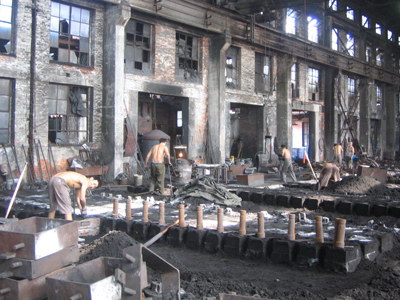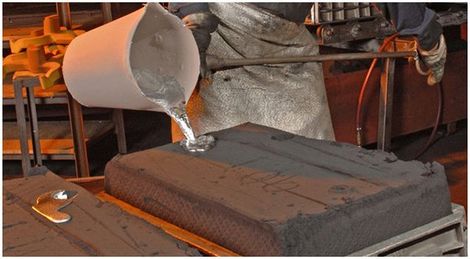A beginner’s guide to the Metal Casting process and its industrial applications
Wiki Article
Discover the Ingenious Techniques Made Use Of in a Metal Foundry for Superior Casting Outcomes
In today's competitive manufacturing landscape, metal foundries are increasingly embracing ingenious methods to boost spreading outcomes - Aluminum Foundry. Advanced computer system simulations permit accurate modeling of liquified metal habits, while 3D printing enables fast production of complicated mold and mildews. In addition, eco-friendly materials and automation streamline procedures. These advancements assure considerable enhancements in effectiveness and top quality control. The influence of these innovations on sustainability and production practices continues to be to be totally explored.Advanced Computer System Simulations in Metal Casting
Advanced computer simulations have actually reinvented the metal spreading process by improving precision and performance. These advanced tools allow engineers to develop digital designs of actors components, allowing them to analyze and forecast the actions of liquified metal during the casting phase. By imitating various criteria such as temperature, flow price, and air conditioning rates, suppliers can identify prospective defects before physical production starts.This proactive strategy decreases waste and lessens pricey mistakes, ultimately resulting in boosted item top quality. In addition, simulations help with the optimization of mold layouts, guaranteeing that they fulfill the particular needs of each job. The combination of computational liquid characteristics (CFD) and limited element analysis (FEA) more adds to the accuracy of these simulations, giving understandings that were formerly unattainable. Consequently, advanced computer system simulations have become a crucial component of modern-day metal foundries, considerably progressing the market's capacities.
3D Printing for Molds and Patterns
3D printing has actually become a groundbreaking technique for creating molds and patterns in the metal foundry industry. This technology makes it possible for the rapid production of complicated geometries that conventional manufacturing approaches struggle to accomplish. By utilizing additive manufacturing, foundries can develop intricate designs with decreased lead times and material waste. The capacity to generate mold and mildews on demand enables better versatility in style versions, helping with faster prototyping and alterations.3D printing can use a range of materials, including metals and plastics, customized to details casting requirements. This flexibility improves the precision of molds, causing superior spreading end results with boosted surface area coatings. Furthermore, the decrease in the number of components called for streamlines setting up processes, further optimizing manufacturing efficiency. As foundries proceed to embrace 3D printing, they are poised to redefine market standards, leading the method for technology and improved productivity in metal casting operations.
Eco-Friendly Products and Processes
As the metal foundry market deals with increasing stress to reduce its environmental impact, the adoption of green products and procedures has ended up being important. Shops are now exploring lasting alternatives to typical materials, such as making use of bio-based binders and recycled steels. These materials not just minimize waste yet additionally lower power consumption during manufacturing.Additionally, advancements in sand spreading techniques have brought about the usage of artificial sands that are much less dangerous to the environment. Foundries are additionally applying ingenious procedures like liquified metal treatment that minimizes emissions and improves the top quality of cast products.
Moreover, water-based finishings have actually replaced toxic solvents, advertising a safer workplace (Aluminum Foundry). By incorporating these green practices, metal foundries can considerably reduce their ecological impact while preserving premium casting outcomes. This change not only benefits the atmosphere but likewise aligns with the expanding consumer demand for lasting manufacturing services
Automation and Robotics in Foundry Operations
While the metal foundry industry embraces innovation, the integration of automation and robotics is changing procedures substantially. Automated systems streamline procedures such as mold and mildew making, metal pouring, and casting completing, considerably boosting performance. Robotics help with the handling of heavy products, minimizing the danger of workplace injuries and making certain more secure environments.
Even more, using automated guided vehicles (AGVs) maximizes material transport within facilities, guaranteeing prompt delivery of elements to ideal workstations. By executing these modern technologies, foundries can adapt to changing needs with greater dexterity, eventually leading to boosted earnings and competitiveness on the market. As automation and robotics proceed to view website progress, they hold the prospective to redefine traditional foundry methods and drive further advancements in casting techniques.
Real-Time Tracking and Quality Assurance Techniques
The advancements in Full Report automation and robotics have actually paved the way for extra innovative strategies to quality guarantee in metal foundries. Real-time monitoring systems use advanced sensing units and data analytics to track critical criteria throughout the casting procedure. These systems continually analyze variables such as temperature, pressure, and product make-up, making it possible for prompt detection of inconsistencies from developed criteria.Quality assurance techniques now integrate artificial intelligence algorithms that evaluate historical information to anticipate possible defects prior to they occur. This aggressive strategy minimizes waste and boosts overall production efficiency. Additionally, integrated comments loopholes permit rapid changes, guaranteeing that each casting satisfies rigid high quality requirements.
The execution of digital doubles-- digital reproductions of physical properties-- has actually likewise reinvented top quality guarantee, permitting designers to replicate and enhance processes in real-time. Together, these ingenious strategies substantially boost the integrity and high quality of castings, setting brand-new industry criteria in metal foundry procedures.
Often Asked Concerns
What Sorts of Metals Are Typically Cast in Foundries?
Commonly cast steels in foundries include light weight aluminum, iron, brass, and bronze. Each metal exhibits one-of-a-kind residential properties, making them appropriate for various applications, such as auto parts, equipment, and creative sculptures, enhancing their convenience in production.
For how long Does the Casting Refine Usually Take?
The spreading process usually takes numerous hours to days, depending on aspects such as the complexity of the mold and mildew, sort of metal utilized, and air site here conditioning needs. Each stage affects the general period substantially.What Precaution Remain In Place for Foundry Workers?

Just how Are Issues in Castings Identified and Addressed?
Issues in spreadings are recognized through aesthetic examinations and non-destructive screening methods. When discovered, foundry workers resolve them by fine-tuning processes, changing material structures, and applying rehabilitative procedures to ensure quality and compliance with criteria.What Is the Expense Variety for Metal Casting Solutions?
The cost variety for metal casting solutions generally ranges $1 to $10 per pound, depending upon elements such as product kind, intricacy of the layout, and manufacturing quantity, affecting total prices considerably.In today's competitive production landscape, metal foundries are significantly taking on cutting-edge methods to boost spreading outcomes. As the metal foundry market faces increasing pressure to decrease its ecological impact, the adoption of eco-friendly materials and procedures has actually ended up being important. Foundries are currently checking out sustainable options to typical products, such as using bio-based binders and recycled steels. By integrating these eco-friendly methods, metal foundries can noticeably lower their environmental effect while maintaining high-grade casting results. The improvements in automation and robotics have led the way for much more advanced techniques to quality assurance in metal foundries.
Report this wiki page